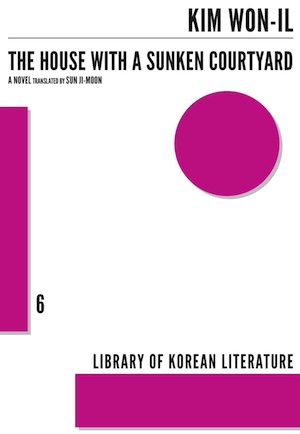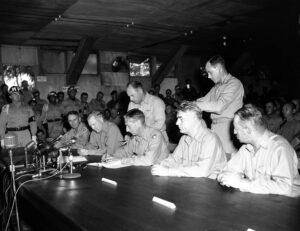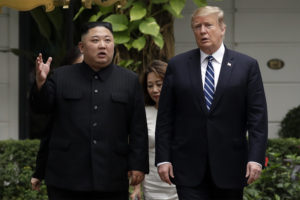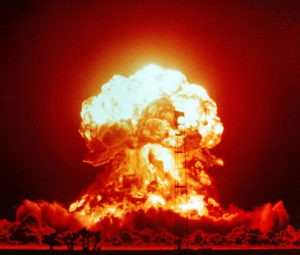The House With a Sunken Courtyard
The narrator of this Korean novel recalls the year that his family spent living alongside four other struggling families in the cramped quarters of a formerly grand old house in the wake of the Korean War.
“The House With a Sunken Courtyard” A book by Kim Won-il, translated from the Korean by Suh Ji-moon
The Korean War (1950-1953) and its ramifications have imprinted themselves on the work of several South Korean fiction writers (there is no literary scene worth mentioning in North Korea, where state ideology governs the arts), perhaps none more so than novelist Kim Won-il, who was consumed with the subject for a good while. Kim was born in 1942 in the southern part of then-united but Japanese-occupied Korea. A few years later, the Japanese were gone, but the country had been divided in two. Kim suffered through the subsequent Korean War as a child, endured the privations it subjected him to afterward, and has since often looked back, especially when writing in the 1970s-1990s. Several of his novels have won acclaim in South Korea, but few have been translated into English. Of these, “Evening Glow,” the tale of a South Korean town seized by communists shortly before the war, appears to be the only one in print. Now, thanks to the tremendous work of translator Suh Ji-moon and the universal outlook of Chicago publisher Dalkey Archive Press, which is putting out a trove of novels and short story collections as part of its Library of Korean Literature project, “The House With a Sunken Courtyard,” by most accounts Kim’s most autobiographical novel, has become available to English-language readers.
“The House with a Sunken Courtyard,” originally published in Korean in 1988, is a melancholy and ruminative tale of hardship and loss endured by ordinary people pummeled by geo-political forces over which they have no control. The narrator, 40-something Kim Gilnam, recalls the year three decades ago that he, his mother and three siblings spent living alongside four other struggling families in the cramped middle and outer quarters of a formerly grand old house — whose inner quarters are inhabited by the landlord’s family — with a distinctive concave courtyard.
It is 1954, one year after the war ends with an armistice, a few million casualties, and the consolidation of the division between communist North Korea and Western-oriented (but undemocratic) South Korea. During the war, Gilnam’s family lost contact with his father, who may have been killed in an air raid on Seoul, the capital of South Korea, when it was under communist control — though this remains unconfirmed. Gilnam’s mother entrusted him to the care of relatives in their hometown of Jinyeong while she tried to find work and a new home in Daegu, a city in the southeastern part of South Korea. The story begins with Gilnam’s elder sister fetching him from Jinyeong, where he has lived for the past three years, and bringing him to the Janggwan-dong district of Daegu. Gilnam is 11 or 12 years old, having just finished primary (roughly equivalent to elementary) school.
“The room our family occupied,” relates Gilnam of their home in the house with a sunken courtyard, “which was only about thirteen cubic meters — the size of a powder compact was how my mother put it — was located at the end of the middle quarters … and the smell of the sewer wafted in through the window all day long.” Still, he realizes that such an abode beats those of many of the worse-off refugees living on the outskirts of the city; they must make do with “plank huts or straw matting huts … which you could only enter bending double and which had no facilities of any kind.” (Kudos to translator Suh for capturing, in English, Kim’s evocation of the confinement and squalor of much housing in postwar South Korea.)
Gilnam may have emerged from the war physically unscathed, but, like millions of Koreans, he and surviving family members cannot escape its ravages. The military conflict has ended, but it continues to determine his lot — keeping him from school for a year, thrusting him into child labor, parceling out the bare minimum of food to his nearly starving family, and obliging them to live in the overcrowded, cold and flood-prone house with a sunken courtyard. These experiences mark him indelibly, so that even as the much older narrator of the novel, he retains an unwavering focus on events he experienced more than three decades earlier.
Gilnam finds work initially by buying a handful of newspapers every day and reselling them at a small profit. Soon after, he becomes an official delivery boy for one of the major newspapers. The money isn’t much better: “Hunger made the whole world look yellow. I drifted through the city streets as if I’d turned into a mollusk, carrying newspapers.” Meanwhile, his mother, who is very strict in order to toughen him up for the harshness of life, toils away sewing clothes for prostitutes and other demimonde figures. “Mother often sat up until after midnight sewing clothes by the light of the kerosene lamp, because electricity was cut off sharply at midnight,” observes Gilnam. “Sometimes her hair got singed from leaning too closely to the lamp.”
Although this is quite a downbeat story, chronicling one miserable experience after another in the life of a protagonist stoic beyond his years, Kim prevents it from descending into mawkishness. That said, he does not make Gilnam grow in any real mental or psychological sense during the year in question. Sure, the boy learns to do all kinds of things — from tricking people into becoming newspaper subscribers to chopping firewood — that prove essential to his family’s survival. Yet he has a repeated tendency to attribute his and others’ tribulations to the war, and sometimes sounds more like a world-weary old sage bemoaning the psychic toll of bloody conflict — “The war and its hardships had turned my mother into such a pitiless woman” — than a put-upon but still restless and ambitious pre-adolescent.
In Kim’s defense, his narrator is a grown man looking back on a year of his childhood, so he might naturally pepper his account with mature musings and opinions. Still, the author’s intention seems to have been to keep this perspective to a minimum. Except for the final pages, where we learn what has since become of most of the people living in or associated with the house with a sunken courtyard all those years ago, Kim generally ensures that the narrator remains unobtrusive, and that we experience most of the events described through the eyes of the younger Gilnam, not his older self. This makes the few exceptions rather jarring.
In the Daegu of 1954, with its teeming masses of refugees (alongside well-heeled folks, as well as both South Korean and U.S. soldiers), concern over the fate of missing loved ones is ubiquitous, even in an atmosphere in which “it seemed that nobody wanted to recall the war or talk about it.” Gilnam’s family, of course, does not know what happened to his father, who may have been killed in the aforementioned air raid, but Gilnam later acknowledges that he may have died in other circumstances, gotten abducted by the North or defected. (This last is apparently what Kim’s father did in real life.) Kim paints a couple of enduring images of secondary and even fleeting characters searching for missing relatives. There is the cheerful, sturdy young man who hauls and chops firewood for some of the residents of the house, and does not hesitate to teach Gilnam how to do the chopping himself, even though it means losing work. A soldier in the North Korean army who was taken prisoner by the South and freed after the war, he always asks the house’s residents whether they’ve come across anyone from his home province in the North. And then there are the “sandwichmen,” who wear “advertisement boards suspended on both their front and back.” The advertisements are in fact pleas for information about missing persons, along with a brief description of their physical appearance.
Back at the house, Kim has Gilnam often refer to three of the neighboring families by their places of origin — Gimcheon, Gyeonggi, Pyongyang — thereby demonstrating the foreignness with which he views them (with the reverse also true), and reminding the reader of the hodgepodge nature of the house’s tenants. The neighbors constantly quarrel over such topics as using the outhouse and switching rooms so as to enhance their living arrangements. They also try to curry favor with the landlord and his family as much as possible. Only once, during a rainstorm whose floods threaten to engulf the house — especially vulnerable due to its sunken courtyard — do the families unite. Everybody, including children and even the landlord’s family (whose members never perform manual labor), comes together to drain the courtyard of water and erect barriers to prevent further flooding. At this moment, when, instead of water submerging the courtyard and destroying the shared house, its residents submerge their regional and class differences beneath a cooperative effort to achieve a common good, Kim fashions a vivid and poignant metaphor for what his fellow Koreans should have done to overcome their country’s divisions.
Rayyan Al-Shawaf is a writer and book critic in Beirut.
| To see long excerpts from “The House With a Sunken Courtyard” at Google Books, click here. |
Independent journalism is under threat and overshadowed by heavily funded mainstream media.
You can help level the playing field. Become a member.
Your tax-deductible contribution keeps us digging beneath the headlines to give you thought-provoking, investigative reporting and analysis that unearths what's really happening- without compromise.
Give today to support our courageous, independent journalists.




You need to be a supporter to comment.
There are currently no responses to this article.
Be the first to respond.